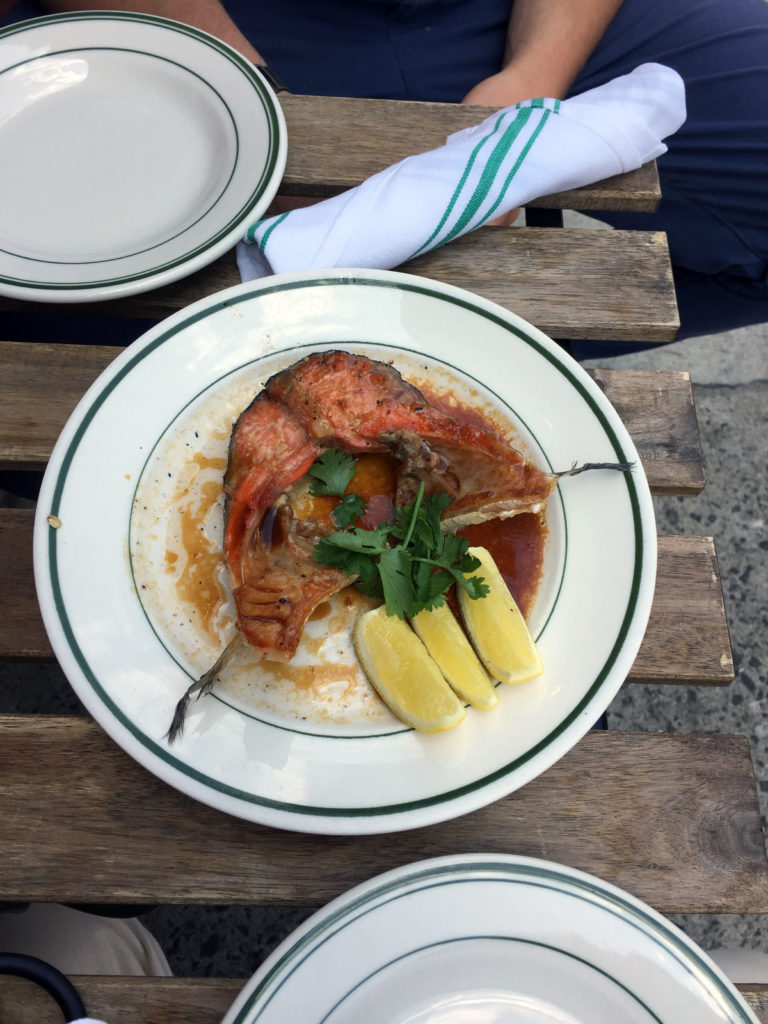So, chances are you’ve heard the phrase nose-to-tail dining, the food movement that encourages eating every part of an animal, not just certain popular cuts. Typically, it’s applied to pigs or cows. But increasingly, restaurants are serving the less popular parts of fish.
Fish collars have been showing up on more and more menus around the country. And to find out why, Brendan met up with Adam Geringer-Dunn. He and his partner Vinny Milburn own Greenpoint Fish & Lobster Co. That’s a seafood market and restaurant that sells whole fish to restaurants around Manhattan.
Brendan met Adam at his shop and asked him to tell him what exactly a fish collar is and why restaurants have been hesitant to incorporate the ingredient on their menus until now.

Adam Geringer-Dunn: Fish collars are a cut of the fish, just behind the head. Kind of where the neck is, before you start getting into the fillet. There’s like a little fin on the side there.
Brendan Francis Newnam: Are there any other names for that cut?
Adam Geringer-Dunn: Fish clavicle? I don’t know.
Brendan Francis Newnam: Fish clavicles don’t have the same ring to it.
Adam Geringer-Dunn: I’m sure there’s a technical name for it, but in the culinary sense of it, we call it a collar.

Brendan Francis Newnam: Part of the reason I’m here is because this cut, is emerging on menus, it seems, more than it has been in the past. Am I just seeing things, or?
Adam Geringer-Dunn: I don’t know. Sometimes I think we might be responsible for that. We have a wholesale business, and we sell a lot of whole fish. And I think we’re selling whole fish to restaurants and they’re looking for ways to use every piece of the fish. And so, they’re using the collars.
‘Cause ordinarily, a lot of restaurants will order fish in fillets already, and you don’t get any of this bone, you don’t get any of the head, the collars. When you get the whole fish, you’re gonna make stock using the frames or the bones, you can use the collars as its own dish on the menu. You can roast the head and serve the head, or serve the cheeks.
And so restaurants– you know, it’s competitive in New York. It’s a really, really difficult business. And people are looking to offset food costs everywhere they can, and collars are a really great place to do that.
Brendan Francis Newnam: I read something you said about how many Americans, when they approach fish, they want just white squares.
Adam Geringer-Dunn: I say that a lot. I think people thought of fish as a white square of protein on a plate. No bones, no skin, no head. And, you know people, “Ahhh!” Again, they freak out when they see a head, or the eyes, and all that…
Brendan Francis Newnam: Even bones. They’ve unfished the fish!
Adam Geringer-Dunn: Exactly. People will come to us in the market, and say, “Does that fish have any bones?” I’m like, “Well, they all have bones. I’ll take ’em out for you, but they have bones.” Even eels have bones, you know. But yeah, I think people are reconnecting with where their food comes from.
Brendan Francis Newnam: We’ve also, we’ve talked to people at the Monterey Bay, and other spots that kinda monitor fish populations, and unfortunately, the decline of them, in many cases. Is this also maybe a response to that? Kind of using all of the protein that comes with these fish we pull from the sea?
Adam Geringer-Dunn: A hundred percent. I think minimizing waste is a huge part of sustainability.
Brendan Francis Newnam: So, previous to this, were fish collars thrown away, or like what happened to them?

Adam Geringer-Dunn: So previously, fish collars were discarded along with the head and the skeleton. A wholesale fishmonger would take the filet off, and they would trim that, make that nice and neat, and they’d sell that to a restaurant.
The yield on a fish collar is pretty minimal. It’s a lot of bone, there are some fins, cartilage, things like that. So the value, in a traditional sense, isn’t there as opposed to a filet. So, that was all getting tossed. I mean, I first came across the idea of fish collars, eating at Japanese restaurants. You’d see Hamachi Kama, or things like that on a menu as its own dish, a standalone dish. And you use chopsticks and you pick at these little chunks, maybe some grated daikon and some soy and stuff like that.
I mean, the collar itself is, is gorgeous, I think, but the meat that comes off is just little nibbles. You know, you get little, little nuggets of meat and flesh here and there, and you have to work for it.
Brendan Francis Newnam: Well like crab legs or something. There’s a lot of work, but once you get those sweet pieces of meat, it’s really rewarding.
Adam Geringer-Dunn: Yeah, the flavor on it is amazing. And the Japanese knew what they were doing. And you know there’s incredible flavor in that cut, and it’s not just dollars and cents in terms of, “Hey there’s not enough meat on here, to put on a plate.” There’s value in the flavor. It doesn’t have to be a huge quantity of meat but there’s, there’s value there.
Brendan Francis Newnam: I’ve read them described as like, the ribs of the sea.
Adam Geringer-Dunn: Yeah I, I kind of think of them as like spare ribs. And you kinda get messy with it. You can hold it up, and you can nibble on it, or dig through it. You’re working through pieces of cartilage and sinew and stuff, and there’s those really good nuggets of juicy meat in there.
But also, kind of like spare ribs, because it’s on the bone, you get incredible flavor into that flesh. Because of the connective tissue, it’s a bit fattier, it holds up a lot better to high heat cooking, broiling, things like that. So, you can get the skin really crispy and a little bit charred, but the flesh itself is still gonna stay super moist and juicy.
Brendan Francis Newnam: OK, so, we’re about to eat this. What kind of fish is this?
Adam Geringer-Dunn: Sockeye salmon. So this is the entire collar. Sometimes you’ll get collars, if it’s a bigger fish, we’ll split it in half. If it’s a smaller fish, we’ll keep it connected where the spine meets the two sides. There are some bones in there, so you just want to work your way around it, but you just find these little morsels of delicious.
Brendan Francis Newnam: Mmm. Yeah.
Adam Geringer-Dunn: This is almost like dark meat, it’s a little bit stronger in flavor. And a little bit darker in color too. But oops! See there a little comes out see. It’s like on the shell there.
Brendan Francis Newnam: Yeah, yeah. Cause it’s fattier, right? Just like dark meat on a chicken.
Adam Geringer-Dunn: Yeah. Exactly. So–
Brendan Francis Newnam: Delicious.

Adam Geringer-Dunn: It’s a little bit stronger in flavor, but–
Brendan Francis Newnam: This isn’t going to feed a family, though.
Adam Geringer-Dunn: You get a couple of these, snack on them. Or it’s a little starter, everyone picks at it. Kind of whet the appetite a little bit.
Brendan Francis Newnam: That is sweet. And what is this? There’s like a tamari?
Adam Geringer-Dunn: Yeah. Typically we just throw a little bit of lemon juice, tamari, and oil on it.
Brendan Francis Newnam: This is delicious. What kind of interesting cuts of fish do you think we’re gonna be seeing more of? Or would you like to see more of, as someone who loves fish?
Adam Geringer-Dunn: I’m looking forward to seeing more offcuts, fish offcuts, all over menus.
Brendan Francis Newnam: And by offcuts, you mean just not the classic fillets.
Adam Geringer-Dunn: Exactly. I’m excited whenever I see a restaurant do like a roasted fish head. Like a giant striped bass, or even like a tuna, an albacore tuna, or something. It’s so dramatic, and so, to me, it’s so cool and really interesting.
Brendan Francis Newnam: Like you mean fish heads, fish heads. Roly-poly fish heads?
Adam Geringer-Dunn: Exactly.


